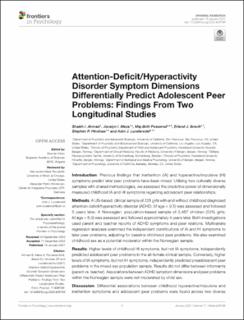| dc.contributor.author | Ahmad, Shaikh I. | |
| dc.contributor.author | Meza, Jocelyn I. | |
| dc.contributor.author | Posserud, Maj-Britt Rocio | |
| dc.contributor.author | Brevik, Erlend Joramo | |
| dc.contributor.author | Hinshaw, Stephen P. | |
| dc.contributor.author | Lundervold, Astri J. | |
| dc.date.accessioned | 2021-08-09T11:39:11Z | |
| dc.date.available | 2021-08-09T11:39:11Z | |
| dc.date.created | 2021-02-12T11:33:37Z | |
| dc.date.issued | 2021 | |
| dc.identifier.issn | 1664-1078 | |
| dc.identifier.uri | https://hdl.handle.net/11250/2767013 | |
| dc.description.abstract | Introduction: Previous findings that inattention (IA) and hyperactive/impulsive (HI) symptoms predict later peer problems have been mixed. Utilizing two culturally diverse samples with shared methodologies, we assessed the predictive power of dimensionally measured childhood IA and HI symptoms regarding adolescent peer relationships.
Methods: A US-based, clinical sample of 228 girls with and without childhood diagnosed attention-deficit/hyperactivity disorder (ADHD; M age = 9.5) was assessed and followed 5 years later. A Norwegian, population-based sample of 3,467 children (53% girls; M age = 8.3) was assessed and followed approximately 4 years later. Both investigations used parent and teacher reports of ADHD symptoms and peer relations. Multivariate regression analyses examined the independent contributions of IA and HI symptoms to later peer problems, adjusting for baseline childhood peer problems. We also examined childhood sex as a potential moderator within the Norwegian sample.
Results: Higher levels of childhood HI symptoms, but not IA symptoms, independently predicted adolescent peer problems in the all-female clinical sample. Conversely, higher levels of IA symptoms, but not HI symptoms, independently predicted preadolescent peer problems in the mixed-sex population sample. Results did not differ between informants (parent vs. teacher). Associations between ADHD symptom dimensions and peer problems within the Norwegian sample were not moderated by child sex.
Discussion: Differential associations between childhood hyperactive/impulsive and inattention symptoms and adolescent peer problems were found across two diverse samples using a shared methodology. Potential explanations for different findings in the clinical vs. population samples include symptom severity as well as age, sex, and cultural factors. We discuss implications for future research, including the importance of dimensional measures of ADHD-related symptoms and the need for shared methodologies across clinical and normative samples. | en_US |
| dc.language.iso | eng | en_US |
| dc.publisher | Frontiers Media | en_US |
| dc.rights | Navngivelse 4.0 Internasjonal | * |
| dc.rights.uri | http://creativecommons.org/licenses/by/4.0/deed.no | * |
| dc.title | Attention-Deficit/Hyperactivity Disorder Symptom Dimensions Differentially Predict Adolescent Peer Problems: Findings From Two Longitudinal Studies | en_US |
| dc.type | Journal article | en_US |
| dc.type | Peer reviewed | en_US |
| dc.description.version | publishedVersion | en_US |
| dc.rights.holder | Copyright 2021 Ahmad, Meza, Posserud, Brevik, Hinshaw and Lundervold | en_US |
| dc.source.articlenumber | 609789 | en_US |
| cristin.ispublished | true | |
| cristin.fulltext | original | |
| cristin.qualitycode | 2 | |
| dc.identifier.doi | 10.3389/fpsyg.2020.609789 | |
| dc.identifier.cristin | 1889140 | |
| dc.source.journal | Frontiers in Psychology | en_US |
| dc.identifier.citation | Frontiers in Psychology. 2021, 11, 609789. | en_US |
| dc.source.volume | 11 | en_US |

